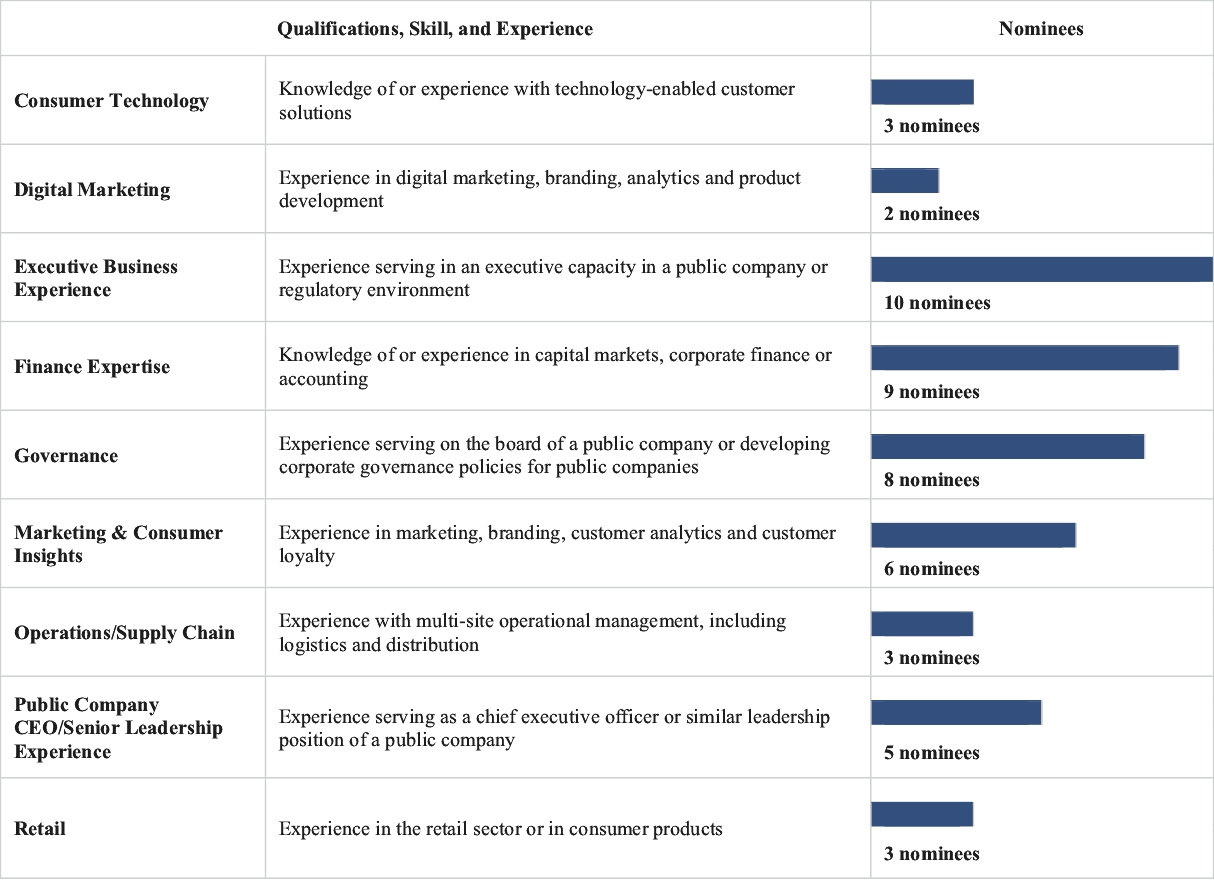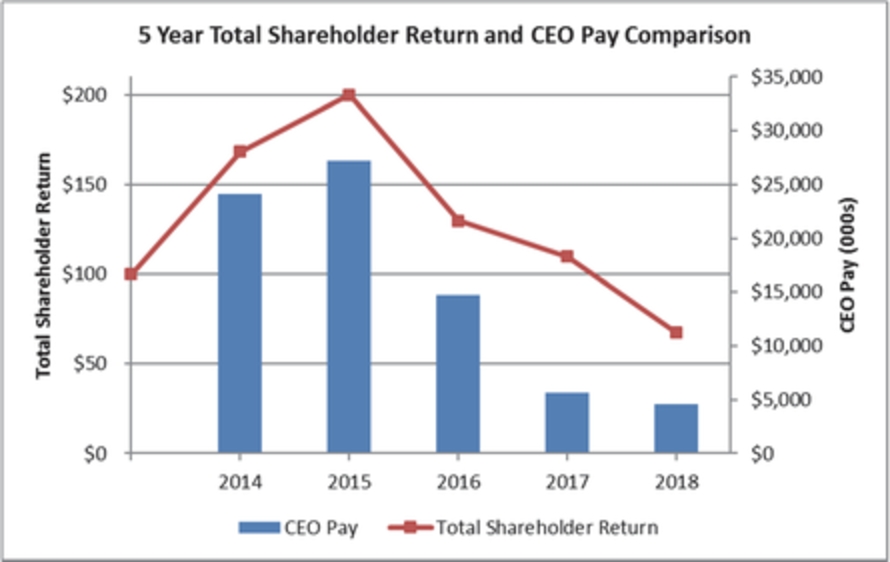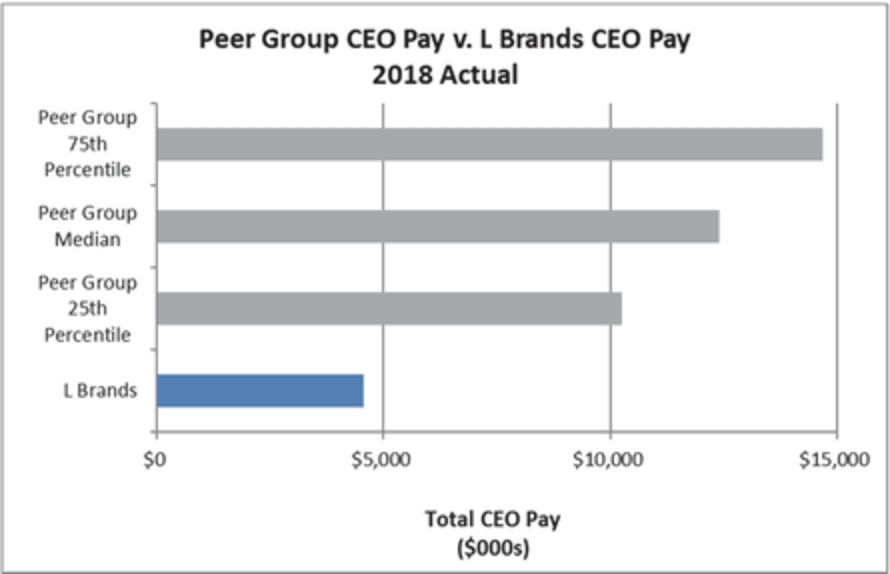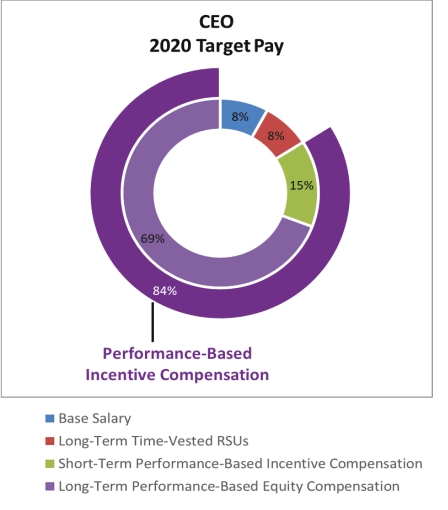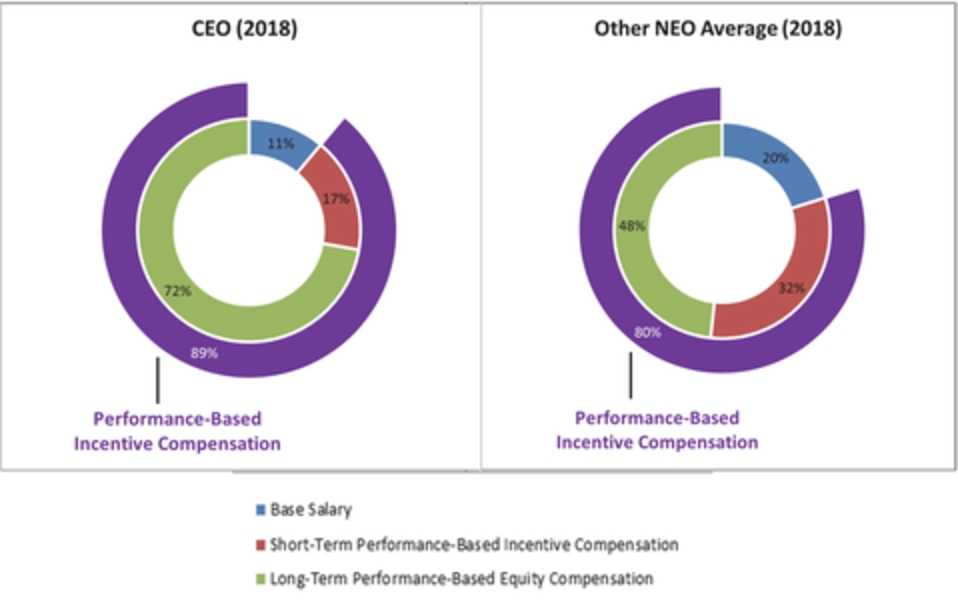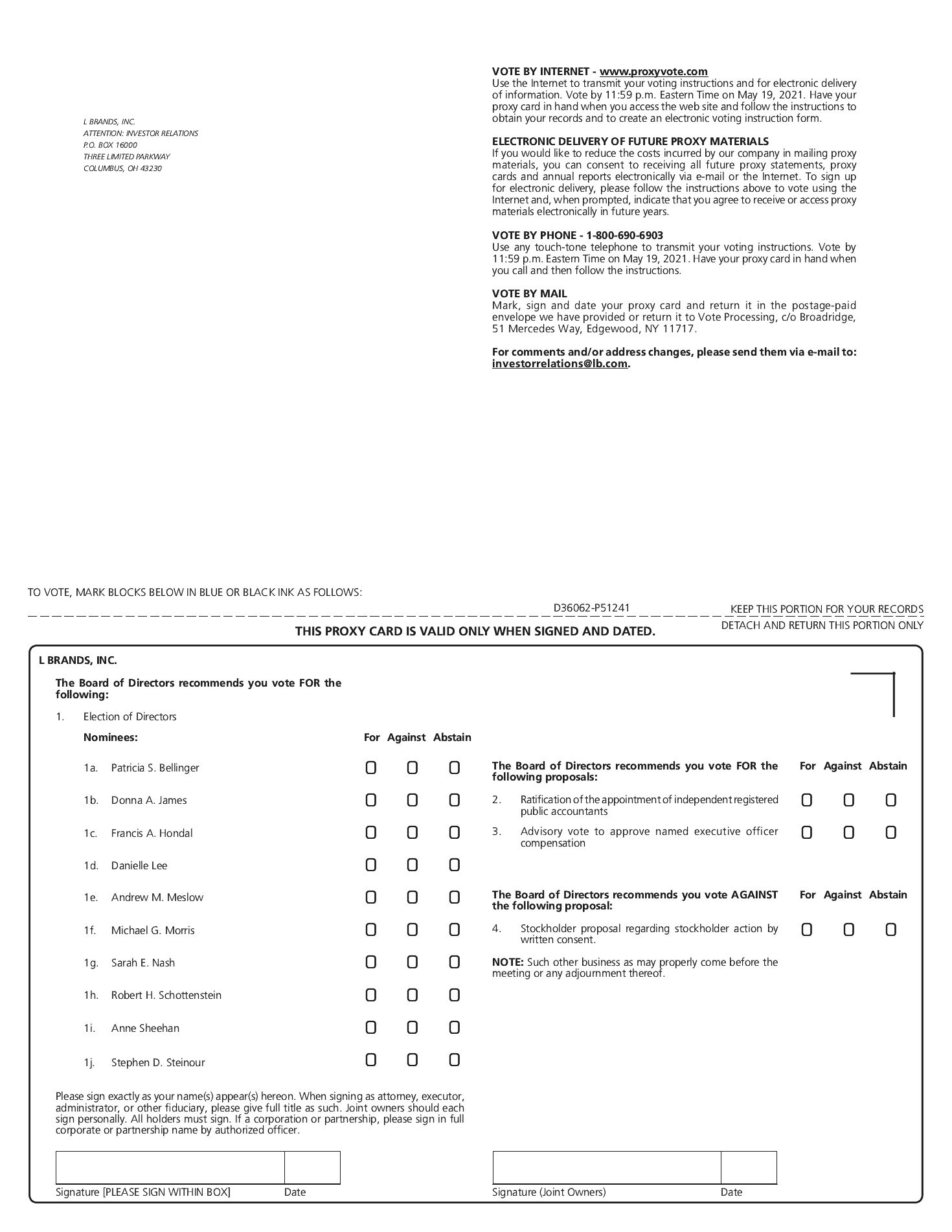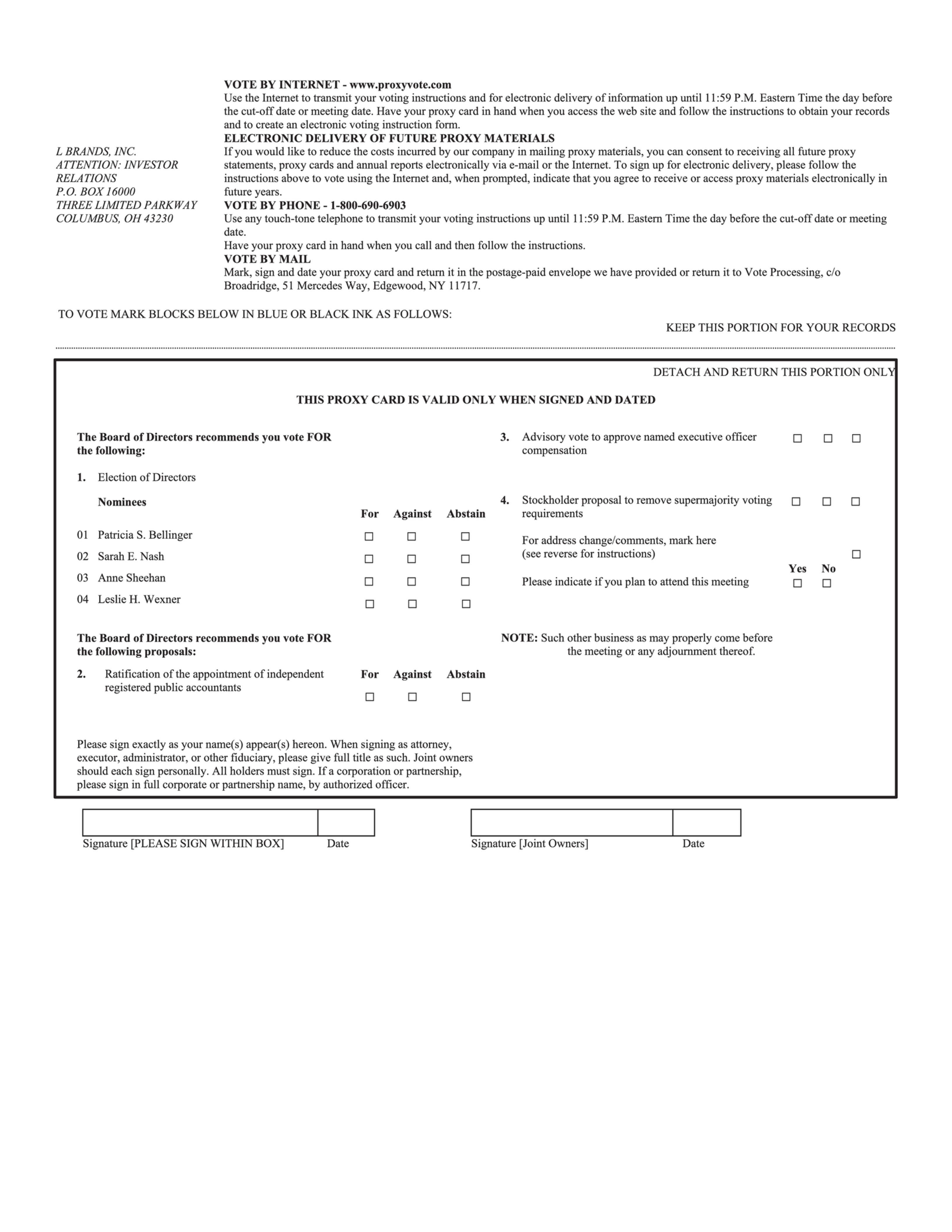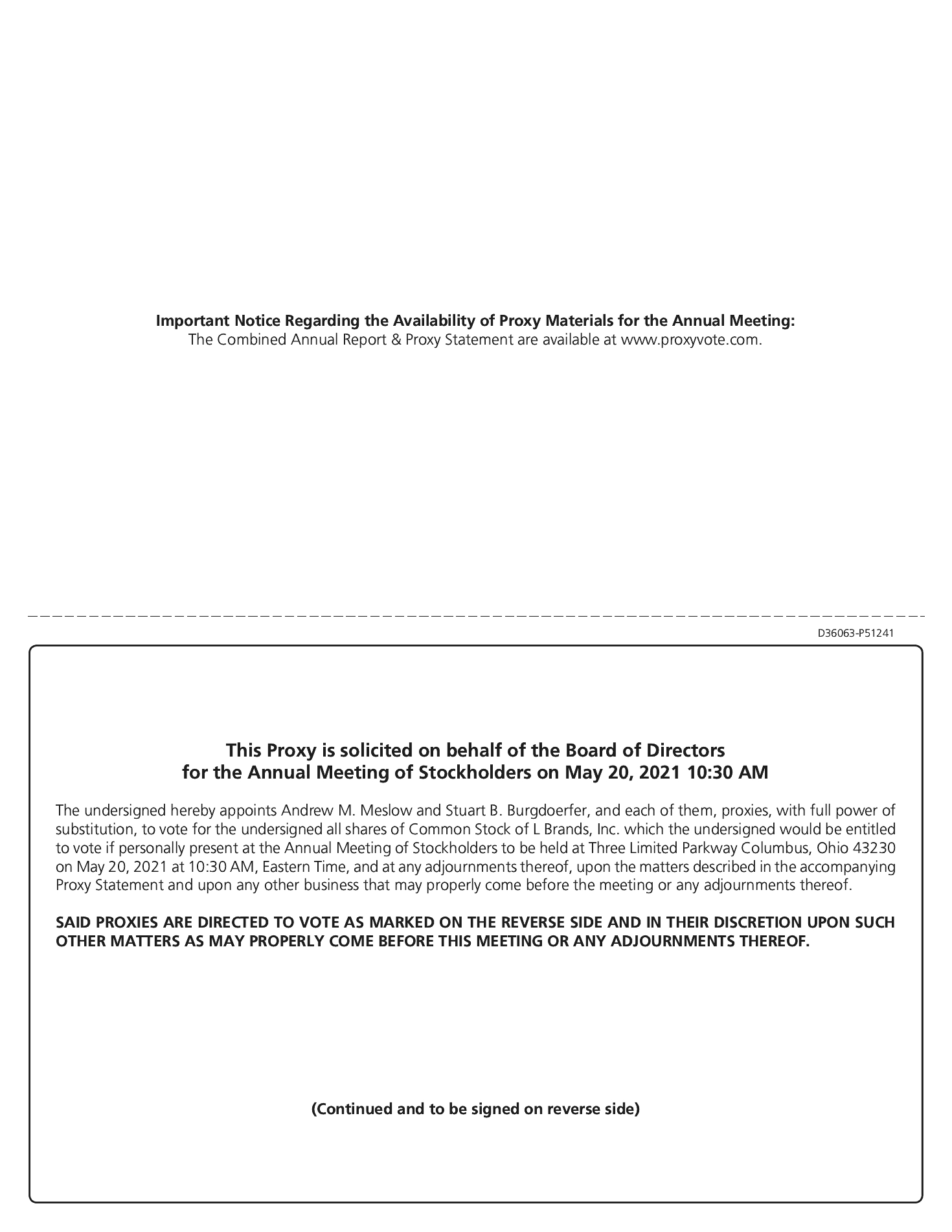TABLE OF CONTENTS
UNITED STATES
SECURITIES AND EXCHANGE COMMISSION
Proxy Statement Pursuant to Section 14(a) of the
Securities Exchange Act of 1934
Filed by the Registrant ☒
Filed by a Party other than the Registrant
o☐
Check the appropriate box:
| o☐
| Preliminary Proxy Statement |
| o☐
| Confidential, for Use of the Commission Only (as permitted by Rule 14a-6(e)(2)) |
| ☒
| Definitive Proxy Statement |
| o☐
| Definitive Additional Materials |
| o☐
| Soliciting Material Pursuant to §240.14a-12 |
L Brands, Inc. |
(Name of Registrant as Specified In Its Charter) |
|
(Name of Person(s) Filing Proxy Statement, if other than the Registrant) |
Payment of Filing Fee (Check the appropriate box):
☒ | | | No fee required. | |
o☐ | | | Fee computed on table below per Exchange Act Rules 14a-6(i)(4) and 0-11. | |
| | | (1) | | | Title of each class of securities to which transaction applies: |
| | |
| | | | | | | |
| | | (2) | | | Aggregate number of securities to which transaction applies: |
| | |
| | | | | | | |
| | | (3) | | | Per unit price or other underlying value of transaction computed pursuant to Exchange Act Rule 0-11 (set forth the amount on which the filing fee is calculated and state how it was determined): |
| | |
| | | | | | | |
| | | (4) | | | Proposed maximum aggregate value of transaction: |
| | |
| | | | | | | |
| | | (5) | | | Total fee paid: | |
| | | | | | | |
o☐ | | | Fee paid previously with preliminary materials. | |
o☐ | | | Check box if any part of the fee is offset as provided by Exchange Act Rule 0-11(a)(2) and identify the filing for which the offsetting fee was paid previously. Identify the previous filing by registration statement number, or the Form or Schedule and the date of its filing. | |
| | | (1) | | | Amount Previously Paid: |
| | |
| | | | | | | |
| | | (2) | | | Form, Schedule or Registration Statement No.: |
| | | | | | | |
| | | (3) | | | Filing Party: | |
| | | | | | | |
| | | (4) | | | Date Filed: | |
| | | | | | | |
TABLE OF CONTENTS
Vote Necessary to Approve Proposals
Pursuant to the Company’s Bylaws, each director will be elected by a majority of the votes cast with respect to such director. A majority of the votes cast means that the number of votes “for” a director’s election must exceed 50% of the votes cast with respect to that director’s election. Any “against” votes will count as a vote cast, but “abstentions” and broker non-votes will not count as a vote cast with respect to that director’s election. Under Delaware law, if the director is not elected at the annual meeting, the director will continue to serve on the Board as a “holdover director.” As required by the Company’s Bylaws, each director has submitted an irrevocable letter of resignation as director that becomes effective if he or she does not receive a majority of votes cast in an election and the Board accepts the resignation. If a director is not elected, the Nominating & Governance Committee will consider the director’s resignation and recommend to the Board whether to accept or reject the resignation.
The ratification of Ernst & Young LLP as our independent registered public accountants requires the affirmative vote of a majority of the votes present in person or by proxy and voting thereon.
The advisory vote to approve named executive officer compensation requires the affirmative vote of a majority of the votes present in person or by proxy and voting thereon. While this vote is required by law, it will neither be binding on the Company or the Board, nor will it create or imply any change in the fiduciary or other duties of, or impose any additional fiduciary or other duties on, the Company or the Board. However, the Human Capital and Compensation Committee (the “HCC Committee”) will take into account the outcome of the vote when considering future executive compensation decisions.
The stockholder proposal requires the affirmative vote of a majority of the votes present in person or byin proxy and voting thereon.
TABLE OF CONTENTS
Impact of Abstentions and Broker Non-Votes
You may “abstain” from voting for any nominee in the election of directors and on the other proposals. Abstentions with respect to the election of directors and on the other proposals will be excluded entirely from the vote and will have no effect.
In addition, under New York Stock Exchange (“NYSE”) rules, if your broker holds your shares in its name, your broker is permitted to vote your shares on the proposal to ratify Ernst & Young LLP as our independent registered public accountants, even if it did not receive voting instructions from you. Your broker may not vote your shares on any of the other matters without specific instruction. A “broker non-vote” occurs when a broker submits a proxy but refrains from voting. Shares represented by broker non-votes are counted as present or represented for purposes of determining the presence of a quorum but are not counted as otherwise present or represented.
TABLE OF CONTENTS
Obtaining Additional Copies of the Proxy Materials
We have adopted a procedure called “householding.” Under this procedure, stockholders who share the same last name and reside at the same mailing address will receive one
Notice or one set of proxy materials
(if they have elected to receive hard copies of the proxy materials), unless one of the stockholders at that address has notified us that they wish to receive individual copies. Stockholders who participate in householding continue to receive separate control numbers for voting. Householding does not in any way affect dividend check mailings.
If you hold Common Stock and currently are subject to householding, but prefer to receive separate copies of proxy materials and other stockholder communications from the Company, or if you are sharing an address with another stockholder and would like to consent to householding, you may revoke or grant your consent to householding as appropriate at any time by calling toll-free at 1-866-540-7095 or notifying our Secretary at our principal executive offices at Three Limited Parkway, Columbus, Ohio 43230.
A number of brokerages and other institutional holders of record have implemented householding. If you hold your shares beneficially in street name, please contact your broker or other intermediary holder of record to request information about householding.
TABLE OF CONTENTS
PROPOSAL 1: ELECTION OF DIRECTORS The Board has nominated
fourten directors for election at the annual meeting. If you elect the
fourten nominees they will hold office for a
three-yearone-year term expiring at the 2022 annual meeting or until their successors have been elected.
Director Succession
The Board believes in the necessity of ongoing Board refreshment, and rigorous self-evaluation, diversity and succession planning.
Over the past year, we have demonstrated this commitment. We
listened to and engagedregularly engage with our
shareholdersstockholders and other stakeholders on Board refreshment. We
focused our efforts on recruiting strategies to identify new directors who embody the skills, experience, diversity and independence of perspective critical to oversee our Company’s strategies for delivering long-term shareholder value. Working with a search firm, the Nominating & Governance Committee recommended Sarah E. Nash and Anne Sheehan as potential director candidates to the Board, and the Board accepted such recommendation and nominated Ms. Nash and Ms. Sheehan to stand for election at the annual meeting. If all of our nominees are elected this year, we would have added
fiveeight new directors since 2014,
and fiveseven of
whom are independent directors. If all director nominees are elected to serve as our
twelvedirectors, six of our directors will be
women.women, including our Chair of the Board, four of whom are ethnically diverse. Information regarding ethnic and gender diversity is based on characteristics self-identified by director nominees.
The Board has in place a robust process that will allow us to continue to refresh the Board and its leadership significantly over the next several years and beyond.Board. We want a thoughtful approach to succession planning and an orderly transition, and the Board seeks to strike a balanced approach that allows the Board to benefit from the right mix of newer directors who bring fresh perspectives and seasoned directors who bring continuity and deep insight into our business and strategies. The Company believes that an effective Board consists of individuals who possess a variety of complementary skills, a range of tenures and a diversity of perspectives. We intend to refresh our Boardassess and assessimplement our Board succession plansplan with this in mind. The Nominating and& Governance Committee and the Board consider the performance, contributions, skills and experience of our Board members in the broader context of the Board’s overall composition, with a view toward constituting a Board that has the integrity, judgment, skill set, experience and other characteristics to oversee the broad set of challenges that the Company faces and evaluate management on executing the Company’s business strategy.
Corporate Governance Highlights
The Board constantly reviews evolving best practices in corporate governance and stays abreast of developments in the area of corporate governance. We have a policy of robust engagement with stockholders, with continuing outreach to and dialogue with all of our major investors on a range of issues, including corporate governance matters and environmental and social goals and initiatives. Corporate governance highlights include:
Board Oversight
Oversees the Company’s strategic plans, capital structure, assessment and management of enterprise risk, cybersecurity and data security policies and environmental, social and governance (“ESG”) matters.
Regular reviews of succession plans for the Chief Executive Officer (the “CEO”) and other senior management positions.
Independent Chair of the Board.
Stockholder Rights and Accountability
Declassified the Board in 2020 – all directors are elected annually.
Removed all supermajority voting requirements in our certificate of incorporation in 2020.
Adopted proxy access, permitting up to 20 stockholders owning 3% or more of the outstanding shares of Common Stock continuously for at least three years to nominate the greater of two directors or up to 20% of our Board and include those nominees in our proxy materials.
Stockholders who own at least 25% of the outstanding shares of Common Stock may call a special meeting of stockholders.
In uncontested director elections, directors are elected by a majority of votes cast.
No “poison pill” in effect.
Annual Evaluations
Annual Board and committee assessments enhance performance.
TABLE OF CONTENTS
Environmental and Social Responsibility
Enterprise strategy for diversity, equity and inclusion.
Reduction of environmental impact through use of sustainably-managed materials and partnerships with environmentally responsible suppliers.
Commitment to improving the communities where we do business, including investing more than $8 million in non-profit organizations in our home office communities through the L Brands Foundation.
Director Experience, Qualifications, Attributes and Skills
We believe that our
Boarddirectors, as a whole,
possessespossess the right mix of qualifications, skills and experience to oversee and address the key issues facing our Company now, and the commitment to Board refreshment to ensure this moving forward.
At Our directors also reflect the Company's 2020 annual meeting,diversity of the Board will submit a proposal to stockholders to amend our certificate of incorporation to declassifyCompany’s workforce, communities it serves, its customers and other key stakeholders.
The table below summarizes the
Board. If such proposal is approved by our stockholders at the Company's 2020 annual meeting, allqualifications, skills and experience of our
directors will standnominees for
election annually for one-year terms beginning at the
Company's 2021 annual meeting.Board.
Set forth below is additional information about the experience and qualifications of each of the nominees for director
as well as each of the current members of the Board, that led the Board to conclude
at the time each individual was nominated to serve on the Board, that he or she would provide valuable insight and guidance as a member of the Board.
Your proxy will vote for each of the nominees unless you specify otherwise. If any nominee is unable to serve, your proxy may vote for another nominee proposed by the Board; alternatively, the Board may elect to reduce the size of the Board. We do not know of any nominee of the Board who would be unable to serve as a director if elected.
TABLE OF CONTENTS
The Board recommends a vote FOR the election of all of the following nominees of the Board:
If you have any questions or require any assistance with voting your shares, please contact our proxy solicitor:

Innisfree M&A Incorporated
501 Madison Avenue, 20th floor
New York, New York 10022
Shareholders may call toll free: (888) 750-5834
Banks and Brokers may call collect: (212) 750-5833
TABLE OF CONTENTS
Nominees and Directors
Nominees of the Board at the 2019 Annual Meeting
Patricia S. Bellinger | | | Director since 2017 | | | Age 5860 |
Human Capital and Compensation Committee
Nominating & Governance Committee |
Ms. Bellinger is the Chief of Staff and Strategic Advisor to the President of Harvard University, an institution of higher education. From 2017 to 2018, she was a Senior Fellow at the Center for Public Leadership at Harvard Kennedy School, a graduate and professional school. From 2013 to 2017, she was an Adjunct Lecturer and the Executive Director at the Center for Public Leadership at the Harvard Kennedy School and from 2010 to 2013, she was the Executive Director of Executive Education at Harvard Business School, a graduate and professional school. Prior to joining Harvard Business School, Ms. Bellinger was group vice president at British Petroleum, a global energy company, from 2000 to 2007, where she oversaw leadership development programs and established and led British Petroleum’s global diversity and inclusion transformation. Ms. Bellinger served as a director of Pattern Energy Group Inc., a power company, from 2013 until 2018 and Paris-based Sodexo S.A., from 2005 until 2018.2018 and as a trustee of uAspire. She also serves as a director of Paris-based Sonepar and as a trustee of uAspire.Safran S.A. Ms. Bellinger’s nomination is supported by her extensive executive, business and leadership experience and service on several boards of directors.
Sarah E. NashDonna A. James
| | | Director Nomineesince 2003 | | | Age 6563 |
Audit Committee
Nominating & Governance Committee |
Ms. Nash is the Chair of the Board and Chief Executive Officer of privately held Novagard Solutions, a manufacturer of silicone sealants, coatings, foam and thermal products, and has held this position since 2018. Ms. Nash spent nearly 30 years in investment banking at JPMorgan Chase & Co. (and predecessor companies), retiring as Vice Chairman, Global Investment Banking, in 2005. Ms. Nash currently serves on the board of Blackbaud, Inc., a software company providing technology solutions for the not-for-profit industry, and has done so since 2010, on the board of Knoll, Inc., a designer and manufacturer of lifestyle and workplace furnishings, textiles and fine leathers, and has done so since 2006, and on the board of privately held Irving Oil Company, and has done so since 2012. Ms. Nash previously served as a director of Merrimack Pharmaceuticals, Inc., a biopharmaceutical company, from 2006 until 2014. Ms. Nash is a trustee of the New York-Presbyterian Hospital, a member of the National Board of the Smithsonian Institution and Chairman of the International Advisory Board of the Montreal Museum of Fine Arts. Ms. Nash’s nomination is supported by her extensive experience in capital markets, strategic transactions, corporate governance and non-profit organizations.
Anne Sheehan
| Director Nominee
| Age 62
|
Ms. Sheehan is the Chair of the Securities and Exchange Commission’s Investor Advisory Committee. From 2008 until 2018, Ms. Sheehan served as the Director of Corporate Governance at The California State Teachers’ Retirement System (CalSTRS), the largest educator-only pension fund in the world and the second largest pension fund in the United States. She previously served as the Chief Deputy Director for Policy at the California Department of Finance from 2004 to 2008 and as Executive Director at the California Building Industry Foundation from 2000 to 2004. Ms. Sheehan is a founder of the Investor Stewardship Group and serves on the Advisory Board of the Weinberg Center for Corporate Governance at the University of Delaware. Ms. Sheehan’s nomination is supported by her extensive experience as a corporate governance professional and her senior management and leadership experience addressing complex legislative, regulatory and public finance issues.
Leslie H. Wexner
| Director since 1963
| Age 81
|
Mr. Wexner has been Chief Executive Officer of the Company since he founded the Company in 1963, and Chairman of the Board for 43 years. Mr. Wexner is the husband of Abigail S. Wexner. Mr. Wexner’s nomination is supported by his effective leadership of the Company since its inception.
Directors Whose Terms Continue until the 2020 Annual Meeting
Donna A. James
| Director since 2003
| Age 61
|
In April 2006, Ms. James established Lardon & Associates LLC, a business and executive advisory services firm, where she is Managing Director. Ms. James served as the President of Nationwide Strategic Investments, a division of Nationwide Mutual Insurance Company, from 2003 through March 2006. Ms. James served as Executive Vice President and Chief Administrative Officer of Nationwide Mutual Insurance Company and Nationwide
TABLE OF CONTENTS
Financial Services from 2000 until 2003. Ms. James is a director of Boston Scientific Corporation, a developer, manufacturer and marketer of medical devices.devices, and The Hartford Financial Services Group, Inc., an investment and insurance company. Ms. James served as a director of Marathon Petroleum Corp., a transportation fuels refiner, from 2011 to 2018.2018, and as an advisor to the Marathon Petroleum Corp. board of directors from 2019 to 2020. Ms. James also served as Chairman of Financial Settlement Services Agency, Inc. from 2005 through 2006, as director of CNO Financial Group, Inc., a holding company for a group of insurance companies, from 2007 to 2011, as director of Coca-Cola Enterprises Inc., a nonalcoholic beverages company, from 2005 to 2012 and as a director of Time Warner Cable Inc., a provider of video, data and voice services, from 2009 to 2016. Ms. James’s nomination wasis supported by her executive experience, financial expertise, service on several boards of directors and experience with respect to corporate diversity and related issues.
Francis A. Hondal | | | Director since 2021 | | | Age 56 |
Ms. Hondal is President of Loyalty and Engagement at Mastercard Incorporated, a global technology company in the payments industry and has served in this position since 2018. She is also a member of Mastercard Incorporated’s management committee and leads the development of products that enable consumer experiences through loyalty, rewards and performance-based marketing services for enterprises worldwide. From 2015 to 2018, Ms. Hondal was Executive Vice President of Credit and Loyalty at Mastercard Incorporated, responsible for growing usage and preference of Mastercard branded products, and from 2011 to 2015 she was Executive Vice President of Products at Mastercard Incorporated. Ms. Hondal also spent 17 years at the American Express Company in global and regional roles within the consumer services division. Since September 2020 Ms. Hondal has served as a director of Equitable Holdings, Inc., a financial service holding company comprised of two principal franchises, Equitable and AllianceBernstein. She is also a board observer for Flybits, a Canadian contextual marketing fintech, and serves on the board of the Florida International University Foundation. Ms. Hondal’s nomination is supported by her extensive consumer marketing, finance and management experience.
TABLE OF CONTENTS
Danielle Lee | | | Director since 2021 | | | Age 45 |
Ms. Lee is the Chief Fan Officer for the National Basketball Association, Inc. where she oversees brand, creative and multiplatform fan marketing globally and is charged with elevating brand perceptions, cultural connection and fan engagement. Prior to joining the NBA in 2020, Ms. Lee served for four years as Global Vice President, Partner Solutions at Spotify Technology S.A., where she was responsible for developing go-to-market strategy and growing global revenue across music, podcasts and high-impact digital experiences. Prior to Spotify, Ms. Lee served as Global Vice President, Commercial Marketing at Vevo LLC and spent seven years at AT&T Inc. and served as Vice President of Product Marketing and Innovation for AT&T AdWorks after beginning her career at Showtime Networks Inc. Ms. Lee’s nomination is supported by her extensive experience and involvement in brand building, product innovation and strategic marketing across technology, media and entertainment.
Andrew M. Meslow | | | Director since 2020 | | | Age 51 |
Mr. Meslow is the Chief Executive Officer of the Company. Prior to his appointment as the Chief Executive Officer of the Company in May 2020, Mr. Meslow was the Chief Executive Officer of Bath & Body Works, a subsidiary of the Company, from February 2020 to May 2020. From 2012 to February 2020, he was the Chief Operating Officer of Bath & Body Works. Mr. Meslow also served in other positions at the Company and its subsidiaries from 2003, when he joined the Company, to 2012. Mr. Meslow’s nomination is supported by his effective leadership of the Company as Chief Executive Officer of the Company, his established track record backed by strong operating, business development and execution skills and his extensive understanding of the Company’s businesses and industry.
Michael G. Morris | | | Director since 2012 | | | Age 7274 |
Human Capital and Compensation Committee (Chair)
Executive Committee
Audit Committee |
Mr. Morris served as the Chairman of the Board of American Electric Power Company, Inc., one of the largest electric utilities in the United States, from 2012 to April 2014. From January 2004 until November 2011, Mr. Morris served as the President, Chief Executive Officer and Chairman of American Electric Power Company, Inc. From 1997 until 2003, he served as the President, Chairman and Chief Executive Officer of Northeast Utilities, the largest electric utility in New England. From 2013 to 2017, Mr. Morris served as a director of Spectra Energy Corp., one of North America’s leading natural gas infrastructure companies until its acquisition by Enbridge Inc., and from From 2017 to 2018, Mr. Morris served as director of Spectra Energy Partners GP, LLC, the general partner of Spectra Energy Partners (DE) GP, LP, the general partner of Spectra Energy Partners, LP, a master limited partnership engaged in the transmission, storage and gathering of natural gas, and the transportation and storage of crude oil, until its acquisition by Enbridge Inc., and from 2018 to 2019, Mr. Morris served as a director of PHL Group, Inc. Mr. Morris currently serves as a director of The Hartford Financial Services Group, Inc., an investment and insurance company, and as the Non-Executive Chairman of the board of directors of Alcoa Corporation, a producer of bauxite, alumina and aluminum. Mr. Morris is also a director of PLH Group, Inc. Mr. Morris served as a director of Alcoa Inc., a producer of aluminum, from 2008 to 2016, until Alcoa Inc.’s separation into two standalone, publicly-traded companies, Alcoa Corporation and Arconic Inc. Mr. Morris’s nomination wasis supported by his broad business experience and management expertise.
Sarah E. Nash | | | Director since 2019 | | | Age 67 |
Chair of the Board
Executive Committee (Chair)
Nominating & Governance Committee (Chair) |
Ms. Nash is the Chair of our Board. Ms. Nash is also Chair of the Board, Chief Executive Officer and majority shareholder of Novagard Solutions, an innovator and manufacturer of silicone sealants and coatings and hybrid and foam solutions for the Building Systems, Electronics, EV and Battery and Industrial and Transportation markets. Ms. Nash spent nearly 30 years in investment banking at JPMorgan Chase & Co. (and predecessor companies), a financial services firm, retiring as Vice Chairman in July 2005. She currently serves on the boards of directors of Blackbaud, Inc., a software company providing technology solutions for the not-for-profit industry, and Knoll, Inc., a designer and manufacturer of lifestyle and workplace furnishing, textiles and fine leathers, and privately held HBD Industries, Inc. and Irving Oil Company. Ms. Nash is Trustee of the New York-Presbyterian Hospital, a member
TABLE OF CONTENTS
of the National Board of the Smithsonian Institution and a member of Smithsonian Tropical Research Institute (STRI), Panama. Ms. Nash holds a BA in political science from Vassar College. Ms. Nash’s nomination is supported by her extensive experience in capital markets, strategic transactions, corporate governance and non-profit organizations.
Robert H. Schottenstein | | | Director since 2017 | | | Age 6668 |
Human Capital and Compensation Committee
Nominating & Governance Committee |
Mr. Schottenstein has been the Chairman and Chief Executive Officer of M/I Homes, Inc., one of the nation’s largest homebuilders, since 2004. He hasFrom 2014 to March 2021, Mr. Schottenstein served on the board of Installed Building Products, Inc., a leading installer of insulation and complementary building products for residential new construction, since 2014.construction. He also serves on the boards of The Ohio State University Wexner Medical Center, One Columbus, 2020, The Ohio State University Foundation and is Vice Chair and serves on the Executive Committee of Harvard University’s Joint Center for Housing. Mr. Schottenstein’s nomination wasis supported by his management and business experience and involvement in various public policy issues.
Raymond ZimmermanAnne Sheehan
| | | Director since 19842019 | | | Age 8664 |
Audit Committee
Nominating & Governance Committee |
Mr. Zimmerman isMs. Sheehan was the Chair of the Securities and Exchange Commission’s Investor Advisory Committee from 2012 to 2020. From 2008 until 2018, Ms. Sheehan served as the Director of Corporate Governance at The California State Teachers’ Retirement System (CalSTRS), the largest educator-only pension fund in the world and the second largest pension fund in the United States. She previously served as the Chief Deputy Director for Policy at the California Department of Finance from 2004 to 2008 and as Executive OfficerDirector at the California Building Industry Foundation from 2000 to 2004. Ms. Sheehan is a director of Service Merchandise LLC,Cohn Robbins Holdings Corp., a retail company. Mr. Zimmerman was Chairmanblank check company founded for the purpose of effecting a merger, share exchange, asset acquisition, share purchase, reorganization or similar business combination with one or more business entities. Ms. Sheehan is a founder of the Board and Chief Executive Officer of 99¢ Stuff, LLC from 1999 to 2003 andInvestor Stewardship Group, serves on the ChairmanAdvisory Board of the Board and Chief Executive Officer of 99¢ Stuff, Inc. from 2003 to 2008. Mr. Zimmerman’s nomination was supported by his financial expertise and broad business experience, particularly in the retail sector.
Directors Whose Terms Continue until the 2021 Annual Meeting
E. Gordon Gee
| Director since 2012
| Age 75
|
Dr. Gee is currently the President of West Virginia University, a large public research institution. Prior to his current serviceWeinberg Center for Corporate Governance at West Virginia University, he led several other major universities, including The Ohio State University (2007—2013, 1990—1998), Vanderbilt University (2000—2007), Brown University (1998—2000), the University of Colorado (1985—1990),Delaware, is a member of the Advisory Board of Rock Center for Corporate Governance of Stanford Law School and West Virginia University (1981—1985). Dr. Gee also currently servesis a Senior Advisor at PJT Camberview. Ms. Sheehan’s nomination is supported by her extensive experience as a director of the National 4-H Council. He previously served as a director of the Company from 1992 to 2008, as a director of Hasbro, Inc., a branded-play company, from 1999 until 2010,corporate governance professional and as a director of Bob Evans Farms, Inc., an ownerher senior management and operator of family restaurants, from 2009 until 2014. Dr. Gee’s nomination was supported by his extensive executiveleadership experience addressing complex legislative, regulatory and management experience, as well as his legal expertise and knowledge of the Company gained through his prior service as a director.
public finance issues.TABLE OF CONTENTS
| | | Director since 2014 | | | Age 6062 |
Audit Committee (Chair)
Executive Committee |
Mr. Steinour has been the Chairman, President & Chief Executive Officer of Huntington Bancshares Incorporated, a regional bank holding company, since 2009. From 2008 to 2009, Mr. Steinour was a Managing Partner in CrossHarbor Capital Partners, LLC, a recognized leading manager of alternative investments. Mr. Steinour was with Citizens Financial Group from 1992 to 2008, where he served in various executive roles, including President from 2005 to 2007 and Chief Executive Officer from 2007 to 2008. Mr. Steinour currentlyalso serves as a directorsupervisory board member of Exelon Corporation,The Clearing House, a utility services holding company.real-time payments platform. He previously served as a trustee of Liberty Property Trust, a real estate investment trust, from 2010 to 2014. Mr. Steinour also serves on the board2014, as a director of the Federal Reserve Bank of Cleveland.Cleveland, from 2017 to 2019, and as a director of Exelon Corporation, a utility services holding company, from 2007 to 2020. Mr. Steinour’s nomination wasis supported by his executive experience, financial expertise and service on several boards of directors.
Allan R. Tessler
| Director since 1987
| Age 82
|
TABLE OF CONTENTSMr. Tessler has been Chairman of
Retiring Directors
Leslie H. Wexner and Abigail S. Wexner have informed the Company that they will retire from the Board
and Chief Executive Officereffective May 20, 2021, at the conclusion of
International Financial Group, Inc., an international merchant banking firm, since 1987 and is the Chairman and Chief Executive Officer of Teton Financial Services, a financial services company. He previously served as Chairman of the Board of Epoch Holding Corporation, an investment management company, from 2004 to 2013, as Chairman of the Board of J Net Enterprises Inc., a technology holding company, from 2000 to 2004, as Chairman of the Board of Imperva, Inc., a provider of cyber security solutions, where he served as a director from 2015 to 2019, and as a director of Steel Partners Holdings GP Inc., a general partner of a global diversified holding company, from 2010 to 2018.our annual meeting. Mr.
Tessler also served as Chairman of the Board of InterWorld Corporation from 2001 to 2004 and as Chairman of Checker Holdings Corp. IV from 1997 to 2009. Mr. Tessler currently serves as Chairman of the Board of Rocky Mountain Bank, a Wyoming bank. He has served as a director of TD Ameritrade Holding Corporation, a securities brokerage company, since November 2006, and as a director of BioCardia, Inc., a clinical-stage regenerative medicine company, since 2012. Mr. Tessler currently serves as the Chair of the Audit Committee of BioCardia, Inc. Mr. Tessler’s nomination was supported by his broad business experience and financial expertise, together with his involvement in various public policy issues.Abigail S. Wexner
| Director since 1997
| Age 57
|
Mrs. Wexner is the chairman, CEO and Founderhusband of Whitebarn Associates, LLC a private investment company. She serves on the boards of Advanced Drainage Systems, Inc., a manufacturer of high performance thermoplastic corrugated pipe, The Ohio State University, Nationwide Children’s Hospital, the Columbus Downtown Development Corporation, the Columbus Partnership, Pelotonia, The Ohio State University Wexner Medical Center, The Wexner Foundation, The Columbus Jewish Federation and the United States Equestrian Team Foundation. She is founder and chair of the board for The Center for Family Safety and Healing, founding board member and vice chair of the board for KIPP Columbus and a past chair of the Governing Committee of the Columbus Foundation. Mrs. Wexner is the wife of Leslie H. Wexner. Mrs. Wexner’s nomination was supported by her executive and legal experience, as well as her expertise with respect to a wide range of diversity, philanthropic and public policy issues.
Former Directors
David T. Kollat and Dennis S. Hersch have determined not to stand for reelection. We thank them for their years of exceptional commitmentcontributions, dedication and distinguished service to the Company.
Accordingly, the size of the Board will be reduced to 10 members immediately following the conclusion of our annual meeting and, therefore, stockholders may only cast their vote with respect to the 10 director nominees described above.
The Board has determined that each of the individuals nominated to serve on the Board
together with David T. Kollat and each of the members of the Board who will continue to serve after the 2019 annual meeting of stockholders (except for
Abigail S. Wexner and Leslie H. Wexner)Andrew M. Meslow), has no material relationship with the Company other than in his or her capacity as a director of the Company and that each is “independent” in accordance with applicable NYSE standards. If all director nominees are elected to serve as our directors, independent directors will constitute
over 80%90% of our Board.
In making these determinations, the Board took into account all factors and circumstances that it considered relevant, including, where applicable, the existence of any employment relationship between the director
(or nominee)nominee or a member of the
director’s (or nominee’s)director nominee’s immediate family and the Company; whether within the past
TABLE OF CONTENTS
three years the director (or nominee)nominee has served as an executive officer of the Company; whether the director (or nominee)nominee or a member of the director’s (or nominee’s)director nominee’s immediate family has received, during any twelve-month period within the last three years, direct compensation from the Company in excess of $120,000; whether the director (or nominee)nominee or a member of the director’s (or nominee’s)director nominee’s immediate family has been, within the last three years, a partner or an employee of the Company’s internal or external auditors; and whether the director (or nominee)nominee or a member of the director’s (or nominee’s)director nominee’s immediate family is employed by an entity that is engaged in business dealings with the Company. The Board has not adopted categorical standards with respect to director independence. The Board believes that it is more appropriate to make independence determinations on a case-by-case basis in light of all relevant factors.
Board Leadership
StructureMr. Leslie H. Wexner serves as Chairman of the Board and Chief Executive Officer (“CEO”) of the Company. Mr. Wexner is the founder of the Company. Mr. Wexner (through his personal and beneficial holdings) is also the Company’s largest stockholder. The Board believes that Mr. Wexner’s experience and expertise in the Company’s business and operations is unrivaled and that he is uniquely qualified to lead the Company. Accordingly, the Company believes that Mr. Wexner’s service as both Chairman of the Board and Chief Executive Officer is a significant benefit to the Company and provides more effective leadership than could be achieved in another leadership structure.
Allan R. Tessler currently serves as the lead independent director. In July 2012, the Board determined that the lead independent director should be appointed solely by the independent directors, as they deem appropriate, and Mr. Tessler was subsequently reappointed as the lead independent director by them. As lead independent director, Mr. Tessler has the authority to call meetings of the independent directors, at which he serves as the chairman. Mr. Tessler also approves information sent to the Board, including the agenda for Board meetings, and is responsible for approving meeting schedules in order to assure that there is sufficient time for discussion of all agenda items.
The Company believes that the lead independent director structure, including Mr. Tessler’s service as lead independent director, offers independent oversight of the Company’s management to complement the leadership that Mr. Wexner provides to the Board as its Chairman.
Structure; Risk Oversight; Certain Compensation Matters
Ms. Nash, an independent director, serves as the Chair of the Board.
The Board, directly and through the Audit Committee and other committees of the Board, takes an active role in the oversight of the Company’s policies with respect to the assessment and management of enterprise risk. Among other things, the Board has policies in place for identifying the senior executive responsible for key risks as well as the Board committees with oversight responsibility for particular key risks. In a number of cases, oversight is conducted by the full Board.
Among other things, the Company, including the
CompensationHCC Committee,
of the Board, has evaluated the Company’s compensation structure from the perspective of enterprise risk. The Company, including the
CompensationHCC Committee, believes that the Company’s compensation structures are appropriate and do not incentivize inappropriate taking of business risks.
The
Board and the Audit Committee
take an active role in thehas oversight of the Company’s cybersecurity and data security policies.
Among other things,All members of the
Board periodically reviews with membersAudit Committee are independent directors. Members of management of the Company
regularly brief the Board on issues relating to information security, fraud, data security and cybersecurity risk and developments, as well as the steps management has taken to monitor and control such exposures.
Review of Strategic Plans and Capital Structure
The Board regularly reviews the Company’s strategic plans and capital structure with a view toward long-term value creation, including environmental, socialcreation.
Board Oversight of Environmental and
governance considerations. The Board also conducts a strategic planning retreat at least annually with senior management.Social Matters TABLE OF CONTENTS
Social Responsibility
The Company is a values-based company, and we strive to operate our business according to high standards of social responsibility. The Board, with the support, as relevant, of its HCC Committee and the Nominating & Governance Committee, reviews issues of social responsibility, including diversity, equity, and inclusion, environmental,ESG and philanthropic and governance matters,initiatives, and the Company’s policies, practices and progress with respect to such issues. Key areas of focus and highlights include:
TABLE OF CONTENTS
CommitmentDiversity, Equity and Inclusion. Led by our Offices of Inclusion, we implemented a more robust enterprise strategy for diversity, equity and inclusion, based on the pillars of recruitment, education and development, engagement and retention, community and business. This includes the recruitment, retention and advancement of diverse talent among our Board, workforce and suppliers, that reflects the customers we serve and our communities. Specifically, we are taking the following steps:
Leaders, including our CEO, are engaging in conversations with individual associates and teams to improving the communities where we do business. In 2018, we donated more than 55,000 associate volunteer hours in the United States, Canadalisten and Asia,learn. We are committed to providing both large and invested more than $15 millionsmall, formal and informal forums for associates to non-profit organizations in our home office communities through the L Brands Foundation.be heard.
EmpoweringWe have gathered and joiningare sharing resources to provide education, tools and insights for our associates on managing bias and being an ally.
As noted below, we have increased our investment in funding research withorganizations that fund the goalfight against racism and inequality.
As an indication of ending cancer. Lastour efforts in this area, we have scored between 95 and 100 on the Human Rights Campaign’s Corporate Equality Index every year together with associates, we raised more than $8.7 million for the James Cancer Centerpast decade, with a perfect score of The Ohio State University, bringing100 in 2020.
Respecting Human Rights and the 10 year total to $59 million. In addition we have sponsored the world’s largest Komen Race for the Cure corporate team for the last nine years.
Selection of vendorsPlanet throughout our Supply Chain. We select suppliers based on their ability and commitment to meet our stringent standards related to safety, and quality, standards, and to follow our strict ethical labor and environmental standards.the environment. The majority of our production comes from the United States, China, Vietnam, Sri Lanka, Indonesia and India and includes many long-term strategic partners. Suppliers are audited for compliance with our supplier code of conduct, with particular emphasis on forced labor.
Reducing our Environmental Impact.
Reduction ofDriving toward sustainable materials. We are working to reduce our environmental impact through the use of more sustainable materials and the introduction of programs to reduce energy consumption.fibers and partnerships with more environmentally responsible suppliers. For example, under the Company’s Forest Products Procurement Policy, we work with our suppliers to source packaging and products that include recycled content or is produced with pulp– including those containing man-made cellulosic fibers – from certified forestry operations and have phased out products sourced fromto reduce the pressures on endangered forests. Additionally, the Company participates in global initiatives to improve cotton farming and, by the end of 2021, will procure 50% of the Company's cotton through these more sustainable sources.
PromotionMinimizing use of environmentally sensitive practices.hazardous chemicals. We are committed to the goal ofhave built a chemical management program (including supplier training) aimed at eliminating the discharge of 14priority chemical categories in conjunction with the manufacturing of our apparel products and have adopted the Zero Discharge of Hazardous Chemicals (ZDHC) Manufacturing Restricted Substances List (MRSL).
Reducing energy consumption, water use and greenhouse gas emissions. We have rolled out numerous energy-efficiency projects, such as use of LED lamps in stores, home offices and distribution centers. We also have a commitment to using efficient means of transporting our goods. Since 2006, we have been a partner in the U.S. Environmental Protection Agency’s SmartWay Transport Partnership program, which works with companies to reduce greenhouse gas emissions and air pollution from transportation of goods. And since 2009, we have been a member of the Ceres Business for Innovative Climate and Energy Policy (BICEP), an advocacy coalition of businesses committed to working with policymakers to pass meaningful energy and climate legislation. With respect to water use, we have taken steps to conserve water use in our buildings and in landscaping.
Supporting our Communities. In 2020, we invested more than $8 million in non-profit organizations in our home office communities through the L Brands Foundation, which included expanding our commitment to long-time community partners, the National Urban League and YWCA, by 2020.donating $1 million in 2020 to each of them (through their national and Columbus-based affiliates) to support the fight against racism and inequality.
TABLE OF CONTENTS
Empowering and advancementJoining our Associates in Funding Research with the Goal of talentEnding Cancer. In 2020, we contributed to organizations such as Pelotonia and Susan G. Komen to support cancer research. Since 2010, L Brands has raised more than $65 million for Pelotonia where 100% of every participant-raised dollar funds cancer research at The Ohio State University Comprehensive Cancer Center – James Cancer Hospital and Solove Research Institute.
Responding to COVID. Utilizing various COVID-19 safety measures that reflectsare designed to align with guidelines from the Centers for Disease Control and Prevention, we have taken a number of steps to protect our employees and customers, we serveincluding use of temperature checks and verifications from our communities. The Company earnedassociates that they are symptom-free; compensation for our associates who are quarantining due to a perfect score on the Human Rights Campaign 2018 Corporate Equality Index.positive COVID-19 test; providing face masks to our associates and instituting policies for use of face masks; taking steps to promote social distancing at our stores, distribution centers and customer care centers; and increasing our cleaning regimen.
Human Capital Management
The Board recognizes that attracting, developing and retaining the best people is crucial to all aspects of the Company’s activities and long-term success and has oversight of the development and implementation of our human capital management programs, including diversity and inclusion practices and initiatives, recruiting, retention and career development and progression. Among other things, the Board reviews with members of management of the Company issues relating to human capital management such as
employeeassociate engagement, workforce planning and demographics, diversity and inclusion strategies and our corporate
culture.culture and in 2020 the Board adopted a new charter for the HCC Committee.
The Board and its Nominating & Governance Committee have developed policies and principles governing succession planning with respect to the CEO and senior management.
Information Concerning Board Meeting Attendance
Our Board held
1023 meetings in fiscal year
2018.2020. During fiscal year
2018,2020, all of the
then-current directors attended 75% or more of the total number of meetings of the Board and of the committees of the Board on which they served (which were held during the period in which they served).
The Audit Committee of the Board is instrumental in the Board’s fulfillment of its oversight responsibilities relating to (i) the integrity of the Company’s financial statements, (ii) the Company’s compliance with legal and regulatory requirements, (iii) the qualifications, independence and performance of the Company’s independent auditors and (iv) the performance of the Company’s internal audit function. The current members of the Audit Committee are
Ms.Mr. Steinour (Chair), Mses. James
(Chair), Dr. Kollat and
Messrs. Schottenstein, TesslerSheehan and
Zimmerman.Mr. Morris. The Board has determined that each of the Audit Committee members meets the independence, expertise and experience standards established by the NYSE and the
Securities and Exchange Commission
(the “Commission”) for service on the Audit Committee of the Board and for designation as an “audit committee financial expert” within the meaning of the regulations promulgated by the Commission.
TABLE OF CONTENTS
The Report of the Audit Committee can be found on page 55 of this proxy statement. The Audit Committee held 1213 meetings in fiscal year 2018.
2020.
Human Capital and Compensation Committee
The CompensationHCC Committee of the Board (i) oversees generally workforce management and development of the human capital of the Company, as well as the Company’s compensation and benefits philosophy and policies, generally, (ii) evaluates the CEO’s performance and overseescompensation and sets his or her compensation, for the CEO, (iii) oversees the evaluation process and compensation structure for other members of the Company’s senior management and (iv) fulfills the other responsibilities set forth in its charter. In 2020, the Board adopted a new charter for the HCC Committee. The current members of the CompensationHCC Committee are Dr. KollatMr. Morris (Chair), Dr. GeeMs. Bellinger and Mr. Morris.Schottenstein. The Board has determined that each of the current Human Capital and Compensation Committee members is “independent” in accordance with applicable NYSE standards.



